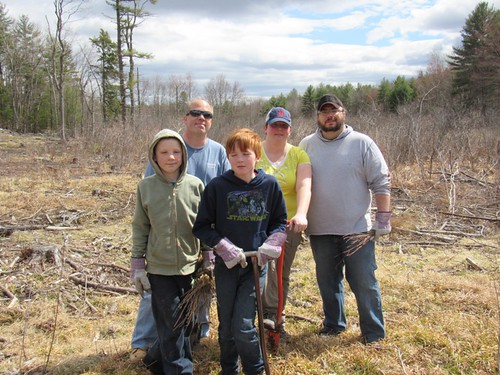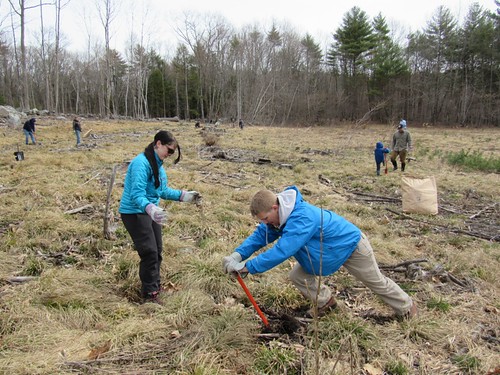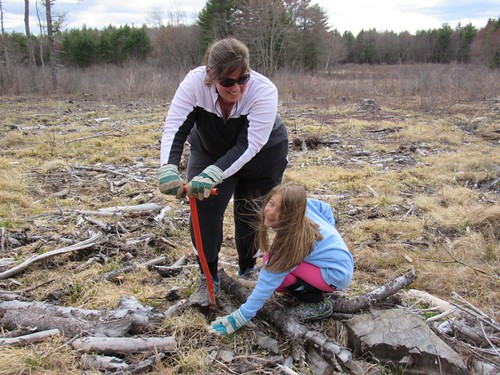
Local boy scout troop members and their families pose with bundles of shrubs and planting bars at the edge of a wetland where they are planting shrubs for New England cottontail habitat. Photo by Phillip Brown, Audubon.
A New Hampshire community came together to help restore habitat for the New England cottontail, a native rabbit of the region. For this rabbit, habitat restoration is pretty simple, planting the shrubs that are the cornerstones of its ideal habitat.
Nearly 40 volunteers gathered in April to plant more than 5,000 shrubs at Smith Sisters Wildlife Sanctuary, a 115-acre sanctuary managed by Audubon. Volunteers planted 10 different shrub species, including elderberry, dogwoods, Virginia rose, American hazelnut, fragrant sumac, eastern red-cedar, nannyberry and arrowwood viburnum.
The shrubs, funded through a Farm Bill conservation program offered by USDA’s Natural Resources Conservation Service (NRCS), were planted in a timbered area, converting it into a thicket of native shrubs.
“I was thrilled to see the amount of community volunteers who came out to create habitat for this state endangered species,” NRCS Soil Conservationist Matthew Larkin said.

A team of two volunteers dig a hole and prepares to plant a native bare-root shrub in an old field setting on a NH Audubon wildlife sanctuary. Photo by Phillip Brown, Audubon
Groups were divided into morning and afternoon shifts, working to get the native shrubs in the ground to help restore thicket habitat needed for the New England cottontail’s survival and for more than 100 wildlife species sharing similar habitat needs, including the American woodcock, blue-winged warbler, whitetail deer and rough grouse.
The primary threat to the rabbit is habitat loss when forests mature, and the region’s only native rabbit has suffered critical population declines over time. This restoration effort is one of many underway to help the rabbit.
Earlier this month, the U.S. Fish and Wildlife Service determined listing under the Endangered Species Act was not necessary for the rabbit. This effort – plus the many more occurring across the region – are helping the species rebound.
The Stewardship Network: New England helped to gather community volunteers, who worked very hard. “We are so fortunate to support these partners and volunteers who came together to help this important effort to grow the numbers of New England cottontails,” NRCS Acting State Conservationist Jade Nield said. “I couldn’t be more proud of what they’ve accomplished.”
Shrubs are fairly easy to plant using shovels, planting bars and a little muscle to open the soil surface to create space for bare roots to naturally set in, plant the shrub and backfill with soil dug from the hole, lightly compacting the soil around the stem and leaving the rest to nature.
Since 2012, NRCS has worked with FWS through the Working Lands for Wildlife partnership to provide financial and technical help to private landowners who voluntarily apply conservation practices to their land, as well as provide regulatory predictability under ESA. Since 2012, more than 5,200 acres of habitat have been restored in the six-state region, including nearly 1,000 acres in New Hampshire.
Efforts to restore thicket habitat for the New England cottontail builds on the historic success of voluntary conservation practices on private lands that benefit wildlife while supporting working lands. Recently, because of proactive steps by private landowners to restore and improve habitat, listing was not required for the greater sage-grouse, the Bi-State sage-grouse or the Arctic grayling and the Oregon chub was delisted.
Learn more about NRCS’ wildlife conservation efforts. To get started with NRCS, visit your local USDA Service Center or www.nrcs.usda.gov/GetStarted.

A mother and daughter duo are enjoying the task of planting hundreds of bare-root native shrubs for New England cottontail habitat on a NH Audubon wildlife sanctuary in Newmarket. Photo by Phillip Brown, Audubon.
No comments:
Post a Comment
Note: Only a member of this blog may post a comment.